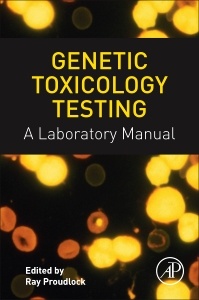Description
Genetic Toxicology Testing
A Laboratory Manual
Coordinator: Proudlock Ray
Language: English
Subject for Genetic Toxicology Testing:
Keywords
Genetic Toxicology; Genotoxicity; Mutagenesis; Toxicity Testing; DNA Damage
Support: Print on demand
Description
/li>Contents
/li>Readership
/li>Biography
/li>Comment
/li>
Genetic Toxicology Testing: A Laboratory Manual presents a practical guide to genetic toxicology testing of chemicals in a GLP environment. The most commonly used assays are described, from laboratory and test design to results analysis. In a methodical manner, individual test methods are described step-by-step, along with equipment, suggested suppliers, recipes for reagents, and evaluation criteria.
An invaluable resource in the lab, this book will help to troubleshoot any assay problems you may encounter to optimise quality and efficiency in your genetic toxicology tests. Genetic Toxicology Testing: A Laboratory Manual is an essential reference for those new to the genetic toxicology laboratory, or anyone involved in setting up their own.
2. Laboratory Design and Safety
3. Formulation
4. Bacterial Mutation Test
5. The Mouse Lymphoma TK Assay
6. In Vitro Micronucleus
7. In Vitro Chromosome Aberration
8. Rodent Micronucleus
9. Rodent Chromosome Aberration
10. Comet Assay
11. PigA Mammalian Erythrocyte Mutation
Ray Proudlock graduated from Thames Polytechnic in Woolwich in 1974. His first laboratory jobs involved plant tissue culture and DNA turnover in cultured lymphocytes. Subsequently, he performed and supervised a wide range of genetic toxicology assays at Huntingdon Life Sciences (HLS, now Envigo), the third largest contract toxicology company in the world. He specialized in practical improvement of the quality and efficiency of test methods, many of which are still in routine use including Ames, in vivo micronucleus, in vitro and in vivo chromosome aberration. While at Huntingdon, he was awarded a master's degree for work on in vitro and in vivo UDS by Swansea University, which remains the academic center of excellence for genetox in the UK.
After 21 years, he left HLS as a principal toxicologist responsible for all in vivo genetox to move to Charles River Laboratories (CRL) in Montreal, Quebec, the largest toxicology facility in the world. At Montreal, he designed the laboratories then established and managed the new Genetic Toxicology facility. He trained the staff and helped set up and validate all the current standard assays from Ames to in vivo comet. The department soon established a sound reputation for quality and on-time reporting in a minimum time-frame while achieving rapid growth and good profitability. He was also responsible for heading the in vitro and in vivo drug metabolism department for a temporary (6-month) period during this time. Ray left CRL after 11 years and has since worked as a Principal Toxicologist at Bausch and Lomb (specializing in ophthalmic drugs and medical devices), as Scientific Director at Moltox (responsible for genetic toxicology testing product improvement and development) and as an independent consultant in genetic toxicology.
He has authored or co-authored numerous technical papers on genetic toxicology testing and was directly involved in the international validation of the rat micronucleus test and its integ
- Offers practical and consistent guidance on the most commonly-performed tests and procedures in a genetic toxicology lab
- Describes standard genetic toxicology assays, their methodology, reagents, suppliers, and analysis of their results
- Includes guidance on general approaches: formulation for in vitro assays, study monitoring, and Good Laboratory Practice (GLP)
- Serves as an essential reference for those new to the genetic toxicology laboratory, or anyone involved in setting up their own lab
These books may interest you

The Toxicologist's Pocket Handbook 178.41 €



